Business Analysis and System Development: Geocaching Project
VerifiedAdded on 2020/02/05
|20
|5349
|243
Project
AI Summary
This project analyzes the development of a geocaching system, focusing on the application of professional skills in business analysis. The assignment begins with defining the vision for the system, which aims to help a user, Wayne Johansen, track his geocaching activities. The project involves dividing the system into two subsystems: one for laptop use and another for smartphones. The first task is to plan the project, including dividing the system into components and creating a work breakdown structure outlining the steps for the first iteration, which involves developing the laptop-based system. The project also covers defining and understanding the requirements, including creating a use case diagram to illustrate user interactions. The report provides a detailed breakdown of the project's phases, emphasizing the importance of planning, analysis, and design in creating a functional and user-friendly geocaching system. The solution includes illustrations such as work breakdown structures and use case diagrams to visually represent the project's different components.

Professional Skills for
Business Analysis
Business Analysis
Paraphrase This Document
Need a fresh take? Get an instant paraphrase of this document with our AI Paraphraser
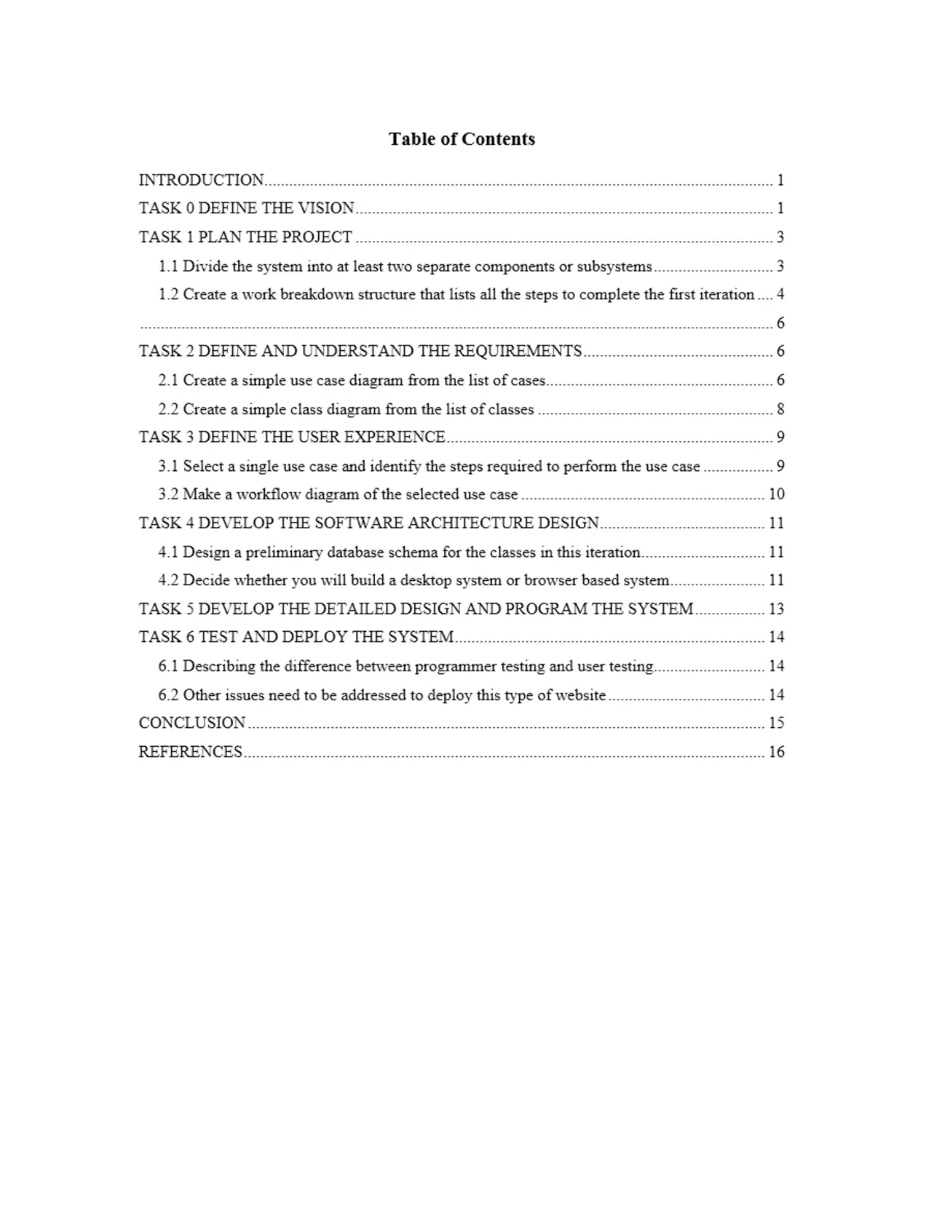
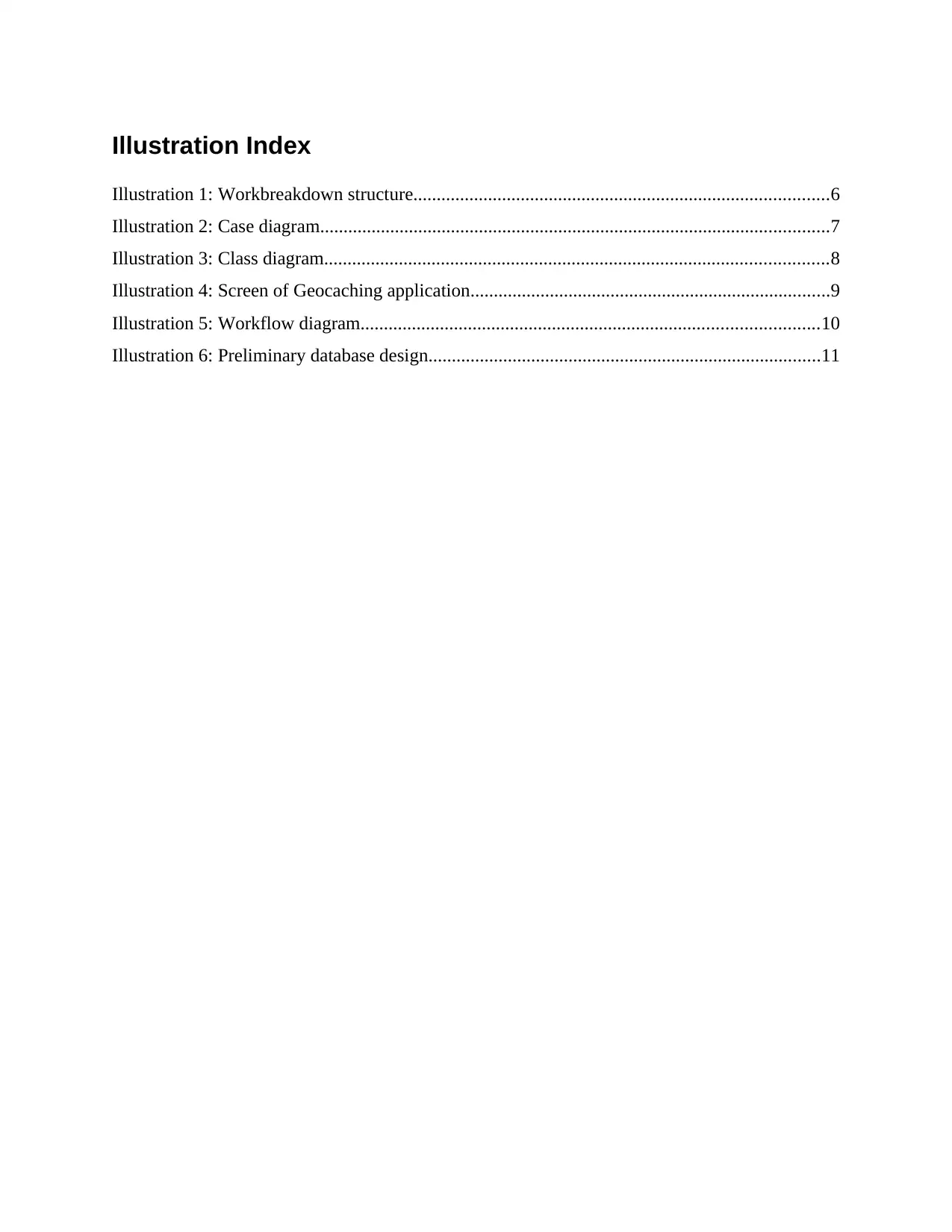
Illustration Index
Illustration 1: Workbreakdown structure.........................................................................................6
Illustration 2: Case diagram.............................................................................................................7
Illustration 3: Class diagram............................................................................................................8
Illustration 4: Screen of Geocaching application.............................................................................9
Illustration 5: Workflow diagram..................................................................................................10
Illustration 6: Preliminary database design....................................................................................11
Illustration 1: Workbreakdown structure.........................................................................................6
Illustration 2: Case diagram.............................................................................................................7
Illustration 3: Class diagram............................................................................................................8
Illustration 4: Screen of Geocaching application.............................................................................9
Illustration 5: Workflow diagram..................................................................................................10
Illustration 6: Preliminary database design....................................................................................11
⊘ This is a preview!⊘
Do you want full access?
Subscribe today to unlock all pages.

Trusted by 1+ million students worldwide
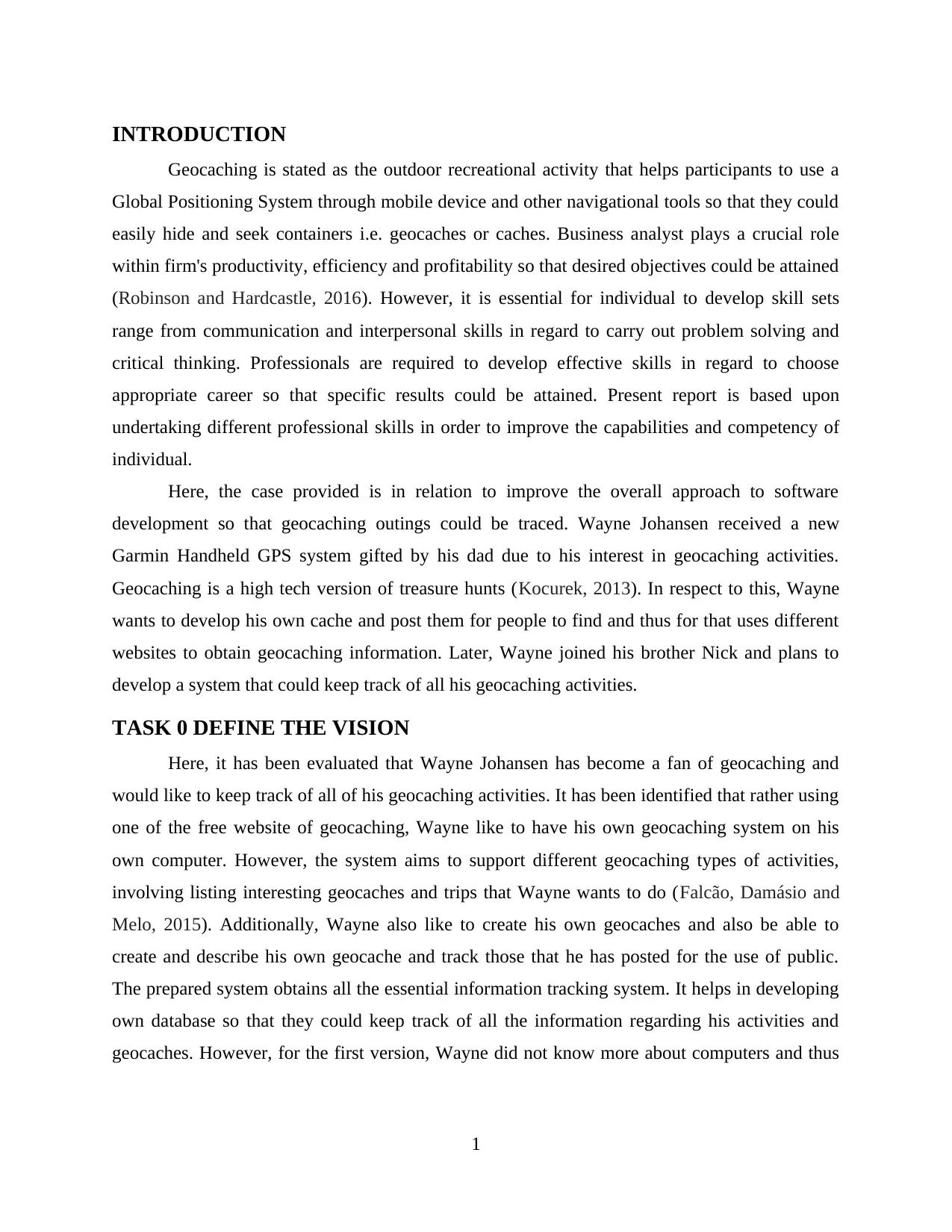
INTRODUCTION
Geocaching is stated as the outdoor recreational activity that helps participants to use a
Global Positioning System through mobile device and other navigational tools so that they could
easily hide and seek containers i.e. geocaches or caches. Business analyst plays a crucial role
within firm's productivity, efficiency and profitability so that desired objectives could be attained
(Robinson and Hardcastle, 2016). However, it is essential for individual to develop skill sets
range from communication and interpersonal skills in regard to carry out problem solving and
critical thinking. Professionals are required to develop effective skills in regard to choose
appropriate career so that specific results could be attained. Present report is based upon
undertaking different professional skills in order to improve the capabilities and competency of
individual.
Here, the case provided is in relation to improve the overall approach to software
development so that geocaching outings could be traced. Wayne Johansen received a new
Garmin Handheld GPS system gifted by his dad due to his interest in geocaching activities.
Geocaching is a high tech version of treasure hunts (Kocurek, 2013). In respect to this, Wayne
wants to develop his own cache and post them for people to find and thus for that uses different
websites to obtain geocaching information. Later, Wayne joined his brother Nick and plans to
develop a system that could keep track of all his geocaching activities.
TASK 0 DEFINE THE VISION
Here, it has been evaluated that Wayne Johansen has become a fan of geocaching and
would like to keep track of all of his geocaching activities. It has been identified that rather using
one of the free website of geocaching, Wayne like to have his own geocaching system on his
own computer. However, the system aims to support different geocaching types of activities,
involving listing interesting geocaches and trips that Wayne wants to do (Falcão, Damásio and
Melo, 2015). Additionally, Wayne also like to create his own geocaches and also be able to
create and describe his own geocache and track those that he has posted for the use of public.
The prepared system obtains all the essential information tracking system. It helps in developing
own database so that they could keep track of all the information regarding his activities and
geocaches. However, for the first version, Wayne did not know more about computers and thus
1
Geocaching is stated as the outdoor recreational activity that helps participants to use a
Global Positioning System through mobile device and other navigational tools so that they could
easily hide and seek containers i.e. geocaches or caches. Business analyst plays a crucial role
within firm's productivity, efficiency and profitability so that desired objectives could be attained
(Robinson and Hardcastle, 2016). However, it is essential for individual to develop skill sets
range from communication and interpersonal skills in regard to carry out problem solving and
critical thinking. Professionals are required to develop effective skills in regard to choose
appropriate career so that specific results could be attained. Present report is based upon
undertaking different professional skills in order to improve the capabilities and competency of
individual.
Here, the case provided is in relation to improve the overall approach to software
development so that geocaching outings could be traced. Wayne Johansen received a new
Garmin Handheld GPS system gifted by his dad due to his interest in geocaching activities.
Geocaching is a high tech version of treasure hunts (Kocurek, 2013). In respect to this, Wayne
wants to develop his own cache and post them for people to find and thus for that uses different
websites to obtain geocaching information. Later, Wayne joined his brother Nick and plans to
develop a system that could keep track of all his geocaching activities.
TASK 0 DEFINE THE VISION
Here, it has been evaluated that Wayne Johansen has become a fan of geocaching and
would like to keep track of all of his geocaching activities. It has been identified that rather using
one of the free website of geocaching, Wayne like to have his own geocaching system on his
own computer. However, the system aims to support different geocaching types of activities,
involving listing interesting geocaches and trips that Wayne wants to do (Falcão, Damásio and
Melo, 2015). Additionally, Wayne also like to create his own geocaches and also be able to
create and describe his own geocache and track those that he has posted for the use of public.
The prepared system obtains all the essential information tracking system. It helps in developing
own database so that they could keep track of all the information regarding his activities and
geocaches. However, for the first version, Wayne did not know more about computers and thus
1
Paraphrase This Document
Need a fresh take? Get an instant paraphrase of this document with our AI Paraphraser
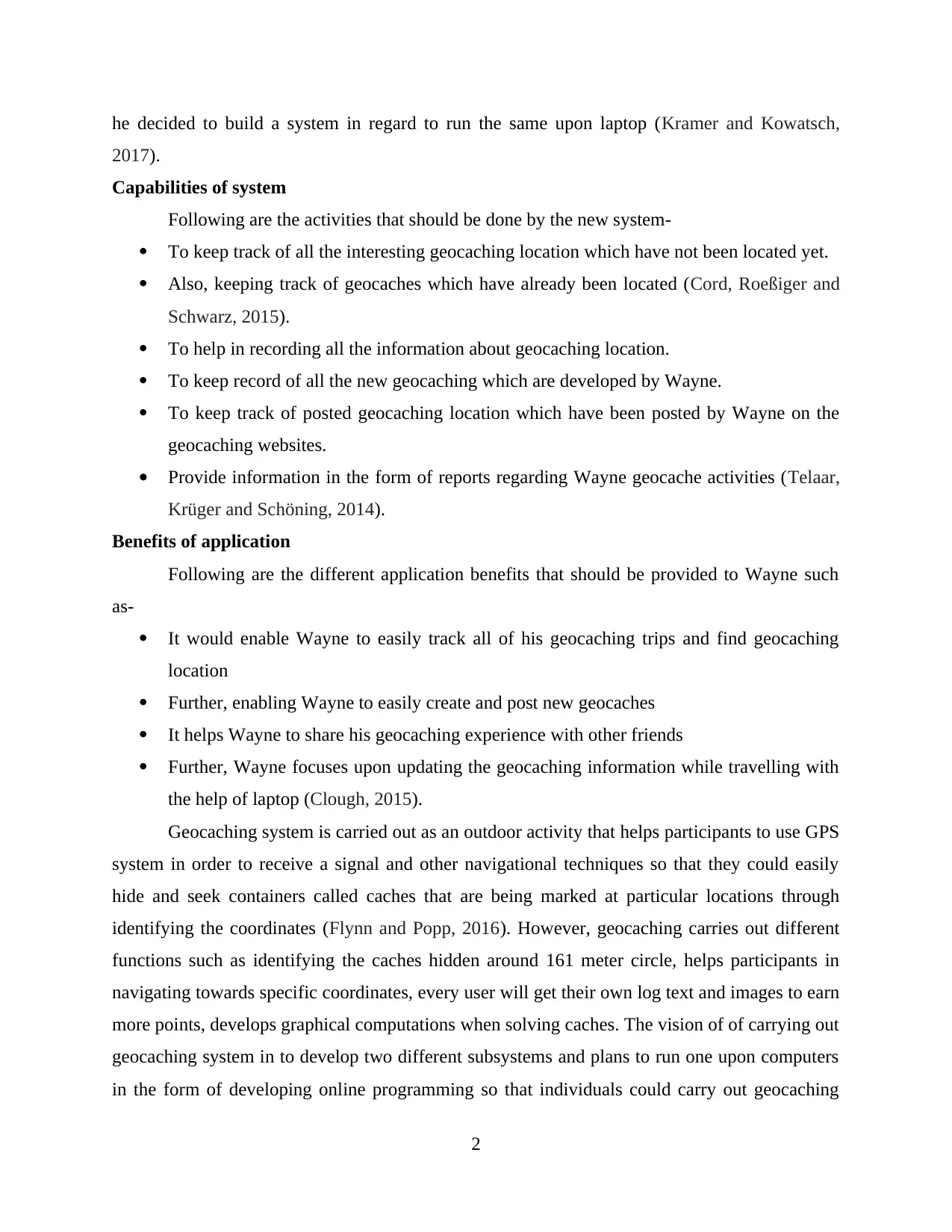
he decided to build a system in regard to run the same upon laptop (Kramer and Kowatsch,
2017).
Capabilities of system
Following are the activities that should be done by the new system-
To keep track of all the interesting geocaching location which have not been located yet.
Also, keeping track of geocaches which have already been located (Cord, Roeßiger and
Schwarz, 2015).
To help in recording all the information about geocaching location.
To keep record of all the new geocaching which are developed by Wayne.
To keep track of posted geocaching location which have been posted by Wayne on the
geocaching websites.
Provide information in the form of reports regarding Wayne geocache activities (Telaar,
Krüger and Schöning, 2014).
Benefits of application
Following are the different application benefits that should be provided to Wayne such
as-
It would enable Wayne to easily track all of his geocaching trips and find geocaching
location
Further, enabling Wayne to easily create and post new geocaches
It helps Wayne to share his geocaching experience with other friends
Further, Wayne focuses upon updating the geocaching information while travelling with
the help of laptop (Clough, 2015).
Geocaching system is carried out as an outdoor activity that helps participants to use GPS
system in order to receive a signal and other navigational techniques so that they could easily
hide and seek containers called caches that are being marked at particular locations through
identifying the coordinates (Flynn and Popp, 2016). However, geocaching carries out different
functions such as identifying the caches hidden around 161 meter circle, helps participants in
navigating towards specific coordinates, every user will get their own log text and images to earn
more points, develops graphical computations when solving caches. The vision of of carrying out
geocaching system in to develop two different subsystems and plans to run one upon computers
in the form of developing online programming so that individuals could carry out geocaching
2
2017).
Capabilities of system
Following are the activities that should be done by the new system-
To keep track of all the interesting geocaching location which have not been located yet.
Also, keeping track of geocaches which have already been located (Cord, Roeßiger and
Schwarz, 2015).
To help in recording all the information about geocaching location.
To keep record of all the new geocaching which are developed by Wayne.
To keep track of posted geocaching location which have been posted by Wayne on the
geocaching websites.
Provide information in the form of reports regarding Wayne geocache activities (Telaar,
Krüger and Schöning, 2014).
Benefits of application
Following are the different application benefits that should be provided to Wayne such
as-
It would enable Wayne to easily track all of his geocaching trips and find geocaching
location
Further, enabling Wayne to easily create and post new geocaches
It helps Wayne to share his geocaching experience with other friends
Further, Wayne focuses upon updating the geocaching information while travelling with
the help of laptop (Clough, 2015).
Geocaching system is carried out as an outdoor activity that helps participants to use GPS
system in order to receive a signal and other navigational techniques so that they could easily
hide and seek containers called caches that are being marked at particular locations through
identifying the coordinates (Flynn and Popp, 2016). However, geocaching carries out different
functions such as identifying the caches hidden around 161 meter circle, helps participants in
navigating towards specific coordinates, every user will get their own log text and images to earn
more points, develops graphical computations when solving caches. The vision of of carrying out
geocaching system in to develop two different subsystems and plans to run one upon computers
in the form of developing online programming so that individuals could carry out geocaching
2
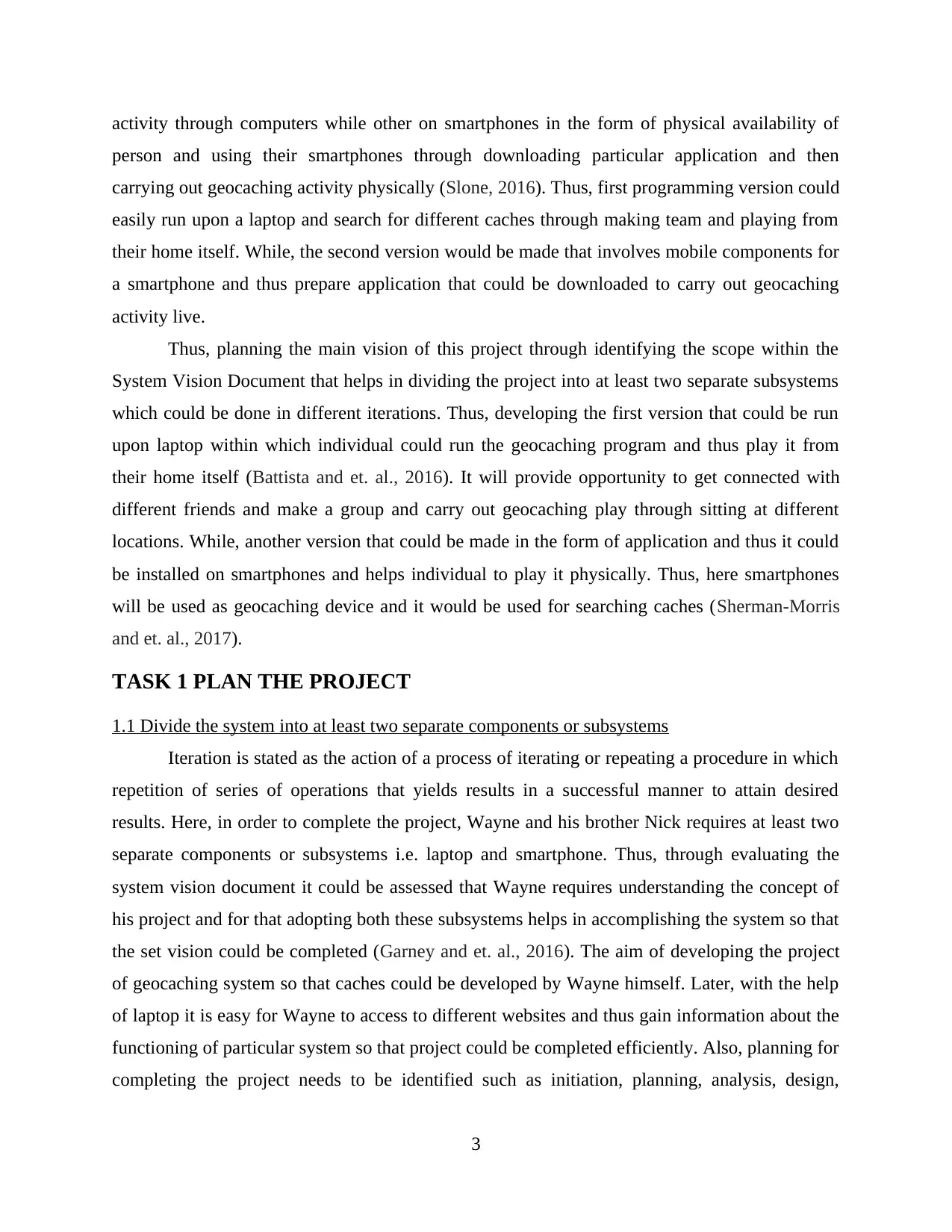
activity through computers while other on smartphones in the form of physical availability of
person and using their smartphones through downloading particular application and then
carrying out geocaching activity physically (Slone, 2016). Thus, first programming version could
easily run upon a laptop and search for different caches through making team and playing from
their home itself. While, the second version would be made that involves mobile components for
a smartphone and thus prepare application that could be downloaded to carry out geocaching
activity live.
Thus, planning the main vision of this project through identifying the scope within the
System Vision Document that helps in dividing the project into at least two separate subsystems
which could be done in different iterations. Thus, developing the first version that could be run
upon laptop within which individual could run the geocaching program and thus play it from
their home itself (Battista and et. al., 2016). It will provide opportunity to get connected with
different friends and make a group and carry out geocaching play through sitting at different
locations. While, another version that could be made in the form of application and thus it could
be installed on smartphones and helps individual to play it physically. Thus, here smartphones
will be used as geocaching device and it would be used for searching caches (Sherman-Morris
and et. al., 2017).
TASK 1 PLAN THE PROJECT
1.1 Divide the system into at least two separate components or subsystems
Iteration is stated as the action of a process of iterating or repeating a procedure in which
repetition of series of operations that yields results in a successful manner to attain desired
results. Here, in order to complete the project, Wayne and his brother Nick requires at least two
separate components or subsystems i.e. laptop and smartphone. Thus, through evaluating the
system vision document it could be assessed that Wayne requires understanding the concept of
his project and for that adopting both these subsystems helps in accomplishing the system so that
the set vision could be completed (Garney and et. al., 2016). The aim of developing the project
of geocaching system so that caches could be developed by Wayne himself. Later, with the help
of laptop it is easy for Wayne to access to different websites and thus gain information about the
functioning of particular system so that project could be completed efficiently. Also, planning for
completing the project needs to be identified such as initiation, planning, analysis, design,
3
person and using their smartphones through downloading particular application and then
carrying out geocaching activity physically (Slone, 2016). Thus, first programming version could
easily run upon a laptop and search for different caches through making team and playing from
their home itself. While, the second version would be made that involves mobile components for
a smartphone and thus prepare application that could be downloaded to carry out geocaching
activity live.
Thus, planning the main vision of this project through identifying the scope within the
System Vision Document that helps in dividing the project into at least two separate subsystems
which could be done in different iterations. Thus, developing the first version that could be run
upon laptop within which individual could run the geocaching program and thus play it from
their home itself (Battista and et. al., 2016). It will provide opportunity to get connected with
different friends and make a group and carry out geocaching play through sitting at different
locations. While, another version that could be made in the form of application and thus it could
be installed on smartphones and helps individual to play it physically. Thus, here smartphones
will be used as geocaching device and it would be used for searching caches (Sherman-Morris
and et. al., 2017).
TASK 1 PLAN THE PROJECT
1.1 Divide the system into at least two separate components or subsystems
Iteration is stated as the action of a process of iterating or repeating a procedure in which
repetition of series of operations that yields results in a successful manner to attain desired
results. Here, in order to complete the project, Wayne and his brother Nick requires at least two
separate components or subsystems i.e. laptop and smartphone. Thus, through evaluating the
system vision document it could be assessed that Wayne requires understanding the concept of
his project and for that adopting both these subsystems helps in accomplishing the system so that
the set vision could be completed (Garney and et. al., 2016). The aim of developing the project
of geocaching system so that caches could be developed by Wayne himself. Later, with the help
of laptop it is easy for Wayne to access to different websites and thus gain information about the
functioning of particular system so that project could be completed efficiently. Also, planning for
completing the project needs to be identified such as initiation, planning, analysis, design,
3
⊘ This is a preview!⊘
Do you want full access?
Subscribe today to unlock all pages.

Trusted by 1+ million students worldwide
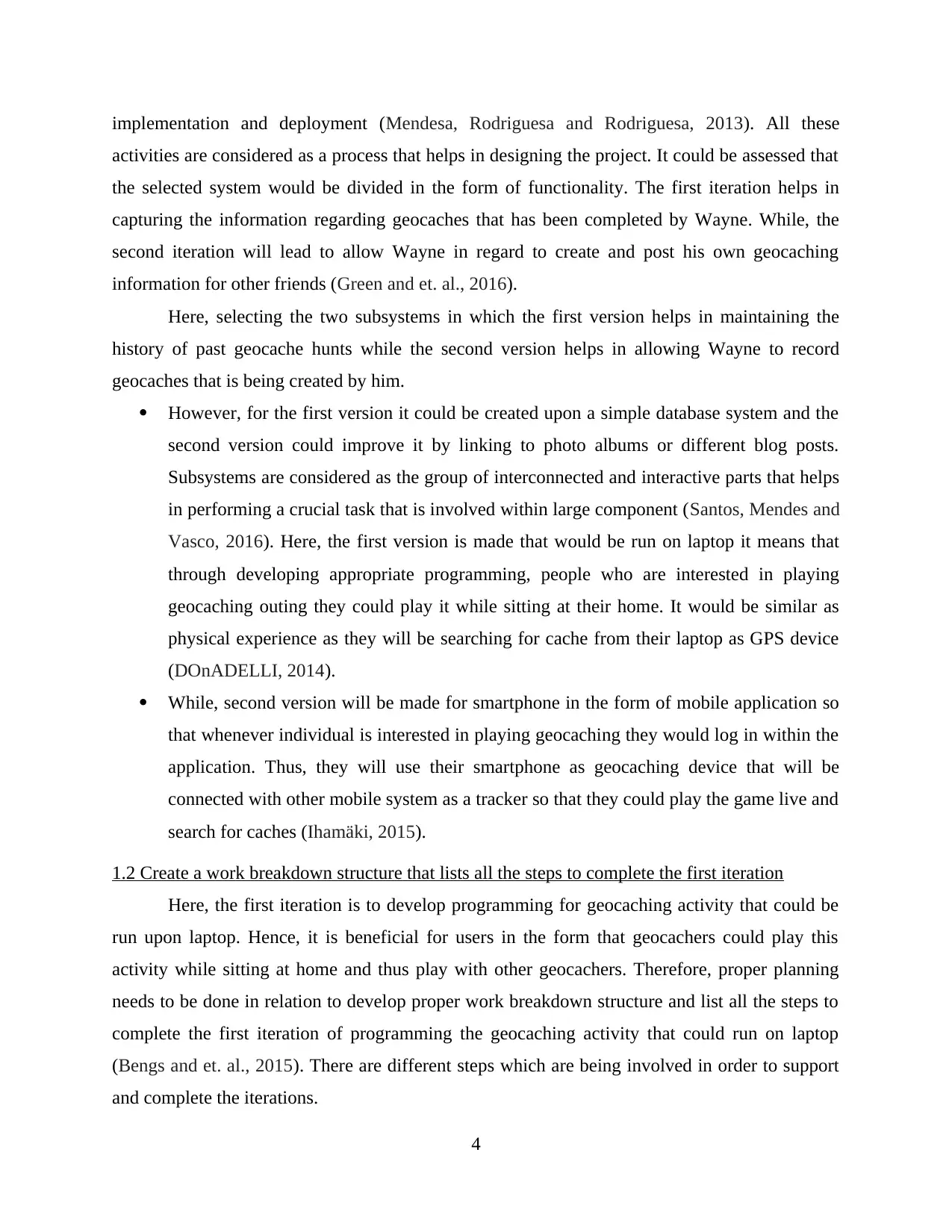
implementation and deployment (Mendesa, Rodriguesa and Rodriguesa, 2013). All these
activities are considered as a process that helps in designing the project. It could be assessed that
the selected system would be divided in the form of functionality. The first iteration helps in
capturing the information regarding geocaches that has been completed by Wayne. While, the
second iteration will lead to allow Wayne in regard to create and post his own geocaching
information for other friends (Green and et. al., 2016).
Here, selecting the two subsystems in which the first version helps in maintaining the
history of past geocache hunts while the second version helps in allowing Wayne to record
geocaches that is being created by him.
However, for the first version it could be created upon a simple database system and the
second version could improve it by linking to photo albums or different blog posts.
Subsystems are considered as the group of interconnected and interactive parts that helps
in performing a crucial task that is involved within large component (Santos, Mendes and
Vasco, 2016). Here, the first version is made that would be run on laptop it means that
through developing appropriate programming, people who are interested in playing
geocaching outing they could play it while sitting at their home. It would be similar as
physical experience as they will be searching for cache from their laptop as GPS device
(DOnADELLI, 2014).
While, second version will be made for smartphone in the form of mobile application so
that whenever individual is interested in playing geocaching they would log in within the
application. Thus, they will use their smartphone as geocaching device that will be
connected with other mobile system as a tracker so that they could play the game live and
search for caches (Ihamäki, 2015).
1.2 Create a work breakdown structure that lists all the steps to complete the first iteration
Here, the first iteration is to develop programming for geocaching activity that could be
run upon laptop. Hence, it is beneficial for users in the form that geocachers could play this
activity while sitting at home and thus play with other geocachers. Therefore, proper planning
needs to be done in relation to develop proper work breakdown structure and list all the steps to
complete the first iteration of programming the geocaching activity that could run on laptop
(Bengs and et. al., 2015). There are different steps which are being involved in order to support
and complete the iterations.
4
activities are considered as a process that helps in designing the project. It could be assessed that
the selected system would be divided in the form of functionality. The first iteration helps in
capturing the information regarding geocaches that has been completed by Wayne. While, the
second iteration will lead to allow Wayne in regard to create and post his own geocaching
information for other friends (Green and et. al., 2016).
Here, selecting the two subsystems in which the first version helps in maintaining the
history of past geocache hunts while the second version helps in allowing Wayne to record
geocaches that is being created by him.
However, for the first version it could be created upon a simple database system and the
second version could improve it by linking to photo albums or different blog posts.
Subsystems are considered as the group of interconnected and interactive parts that helps
in performing a crucial task that is involved within large component (Santos, Mendes and
Vasco, 2016). Here, the first version is made that would be run on laptop it means that
through developing appropriate programming, people who are interested in playing
geocaching outing they could play it while sitting at their home. It would be similar as
physical experience as they will be searching for cache from their laptop as GPS device
(DOnADELLI, 2014).
While, second version will be made for smartphone in the form of mobile application so
that whenever individual is interested in playing geocaching they would log in within the
application. Thus, they will use their smartphone as geocaching device that will be
connected with other mobile system as a tracker so that they could play the game live and
search for caches (Ihamäki, 2015).
1.2 Create a work breakdown structure that lists all the steps to complete the first iteration
Here, the first iteration is to develop programming for geocaching activity that could be
run upon laptop. Hence, it is beneficial for users in the form that geocachers could play this
activity while sitting at home and thus play with other geocachers. Therefore, proper planning
needs to be done in relation to develop proper work breakdown structure and list all the steps to
complete the first iteration of programming the geocaching activity that could run on laptop
(Bengs and et. al., 2015). There are different steps which are being involved in order to support
and complete the iterations.
4
Paraphrase This Document
Need a fresh take? Get an instant paraphrase of this document with our AI Paraphraser
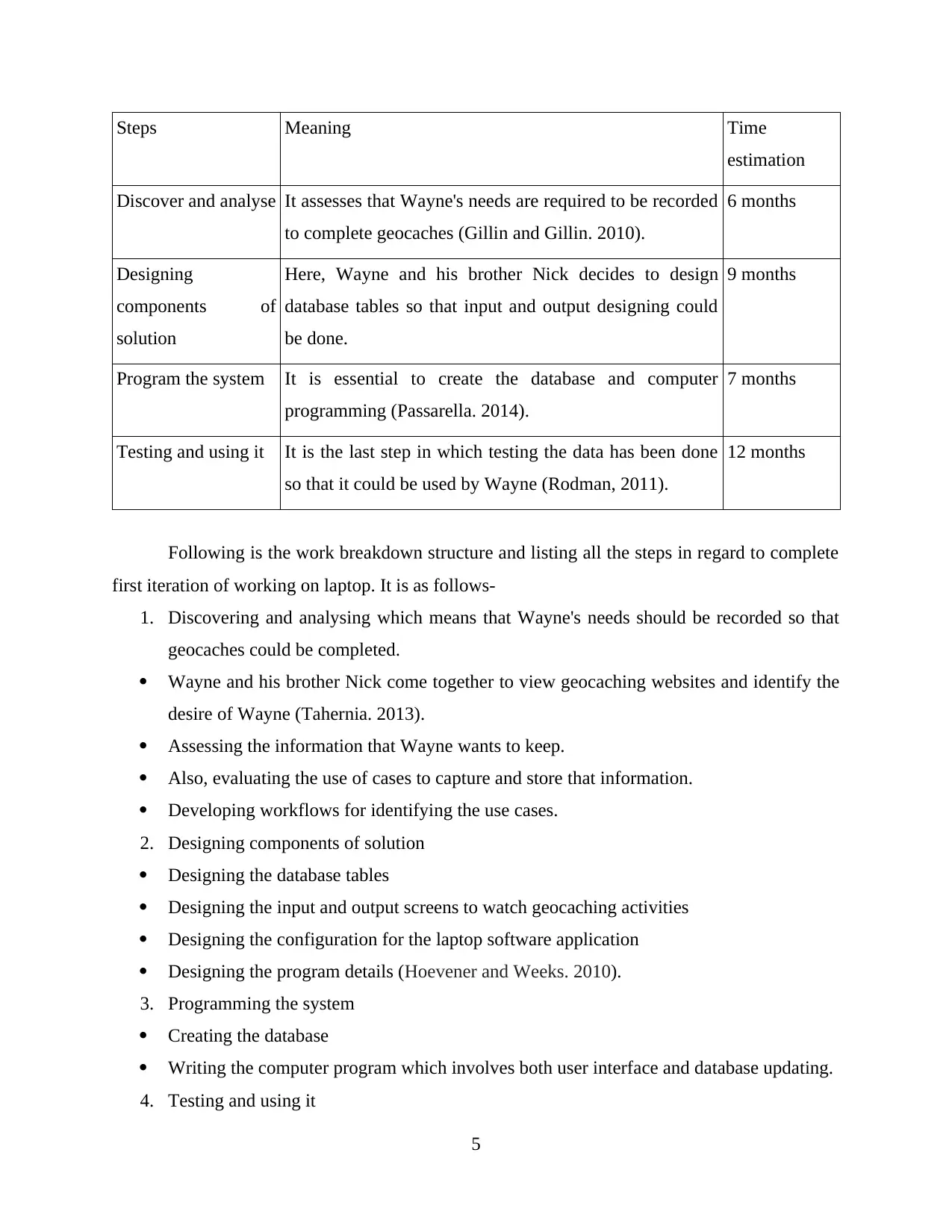
Steps Meaning Time
estimation
Discover and analyse It assesses that Wayne's needs are required to be recorded
to complete geocaches (Gillin and Gillin. 2010).
6 months
Designing
components of
solution
Here, Wayne and his brother Nick decides to design
database tables so that input and output designing could
be done.
9 months
Program the system It is essential to create the database and computer
programming (Passarella. 2014).
7 months
Testing and using it It is the last step in which testing the data has been done
so that it could be used by Wayne (Rodman, 2011).
12 months
Following is the work breakdown structure and listing all the steps in regard to complete
first iteration of working on laptop. It is as follows-
1. Discovering and analysing which means that Wayne's needs should be recorded so that
geocaches could be completed.
Wayne and his brother Nick come together to view geocaching websites and identify the
desire of Wayne (Tahernia. 2013).
Assessing the information that Wayne wants to keep.
Also, evaluating the use of cases to capture and store that information.
Developing workflows for identifying the use cases.
2. Designing components of solution
Designing the database tables
Designing the input and output screens to watch geocaching activities
Designing the configuration for the laptop software application
Designing the program details (Hoevener and Weeks. 2010).
3. Programming the system
Creating the database
Writing the computer program which involves both user interface and database updating.
4. Testing and using it
5
estimation
Discover and analyse It assesses that Wayne's needs are required to be recorded
to complete geocaches (Gillin and Gillin. 2010).
6 months
Designing
components of
solution
Here, Wayne and his brother Nick decides to design
database tables so that input and output designing could
be done.
9 months
Program the system It is essential to create the database and computer
programming (Passarella. 2014).
7 months
Testing and using it It is the last step in which testing the data has been done
so that it could be used by Wayne (Rodman, 2011).
12 months
Following is the work breakdown structure and listing all the steps in regard to complete
first iteration of working on laptop. It is as follows-
1. Discovering and analysing which means that Wayne's needs should be recorded so that
geocaches could be completed.
Wayne and his brother Nick come together to view geocaching websites and identify the
desire of Wayne (Tahernia. 2013).
Assessing the information that Wayne wants to keep.
Also, evaluating the use of cases to capture and store that information.
Developing workflows for identifying the use cases.
2. Designing components of solution
Designing the database tables
Designing the input and output screens to watch geocaching activities
Designing the configuration for the laptop software application
Designing the program details (Hoevener and Weeks. 2010).
3. Programming the system
Creating the database
Writing the computer program which involves both user interface and database updating.
4. Testing and using it
5
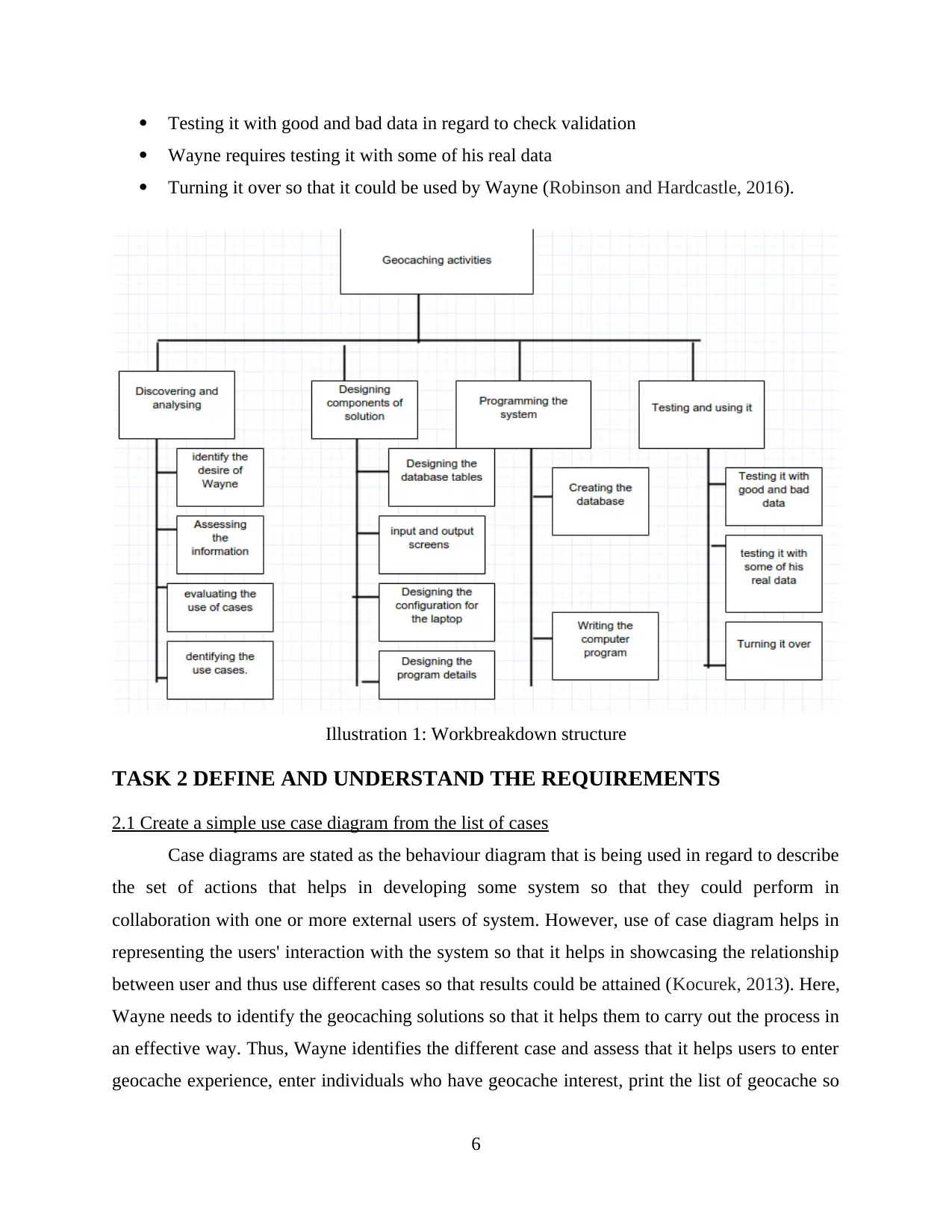
Testing it with good and bad data in regard to check validation
Wayne requires testing it with some of his real data
Turning it over so that it could be used by Wayne (Robinson and Hardcastle, 2016).
Illustration 1: Workbreakdown structure
TASK 2 DEFINE AND UNDERSTAND THE REQUIREMENTS
2.1 Create a simple use case diagram from the list of cases
Case diagrams are stated as the behaviour diagram that is being used in regard to describe
the set of actions that helps in developing some system so that they could perform in
collaboration with one or more external users of system. However, use of case diagram helps in
representing the users' interaction with the system so that it helps in showcasing the relationship
between user and thus use different cases so that results could be attained (Kocurek, 2013). Here,
Wayne needs to identify the geocaching solutions so that it helps them to carry out the process in
an effective way. Thus, Wayne identifies the different case and assess that it helps users to enter
geocache experience, enter individuals who have geocache interest, print the list of geocache so
6
Wayne requires testing it with some of his real data
Turning it over so that it could be used by Wayne (Robinson and Hardcastle, 2016).
Illustration 1: Workbreakdown structure
TASK 2 DEFINE AND UNDERSTAND THE REQUIREMENTS
2.1 Create a simple use case diagram from the list of cases
Case diagrams are stated as the behaviour diagram that is being used in regard to describe
the set of actions that helps in developing some system so that they could perform in
collaboration with one or more external users of system. However, use of case diagram helps in
representing the users' interaction with the system so that it helps in showcasing the relationship
between user and thus use different cases so that results could be attained (Kocurek, 2013). Here,
Wayne needs to identify the geocaching solutions so that it helps them to carry out the process in
an effective way. Thus, Wayne identifies the different case and assess that it helps users to enter
geocache experience, enter individuals who have geocache interest, print the list of geocache so
6
⊘ This is a preview!⊘
Do you want full access?
Subscribe today to unlock all pages.

Trusted by 1+ million students worldwide
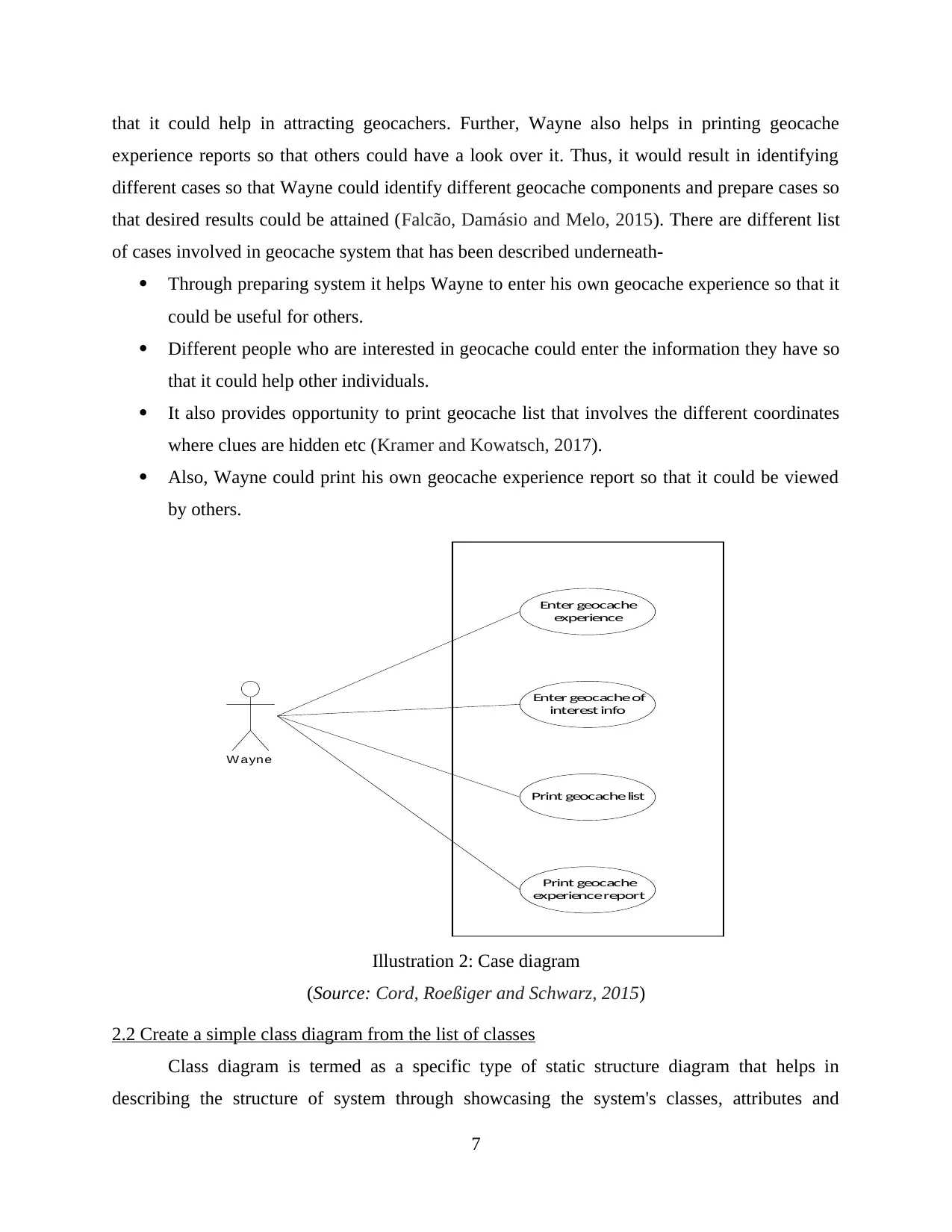
that it could help in attracting geocachers. Further, Wayne also helps in printing geocache
experience reports so that others could have a look over it. Thus, it would result in identifying
different cases so that Wayne could identify different geocache components and prepare cases so
that desired results could be attained (Falcão, Damásio and Melo, 2015). There are different list
of cases involved in geocache system that has been described underneath-
Through preparing system it helps Wayne to enter his own geocache experience so that it
could be useful for others.
Different people who are interested in geocache could enter the information they have so
that it could help other individuals.
It also provides opportunity to print geocache list that involves the different coordinates
where clues are hidden etc (Kramer and Kowatsch, 2017).
Also, Wayne could print his own geocache experience report so that it could be viewed
by others.
Enter geocache
experience
Enter geocache of
interest info
Print geocache list
Print geocache
experience report
W ayne
Illustration 2: Case diagram
(Source: Cord, Roeßiger and Schwarz, 2015)
2.2 Create a simple class diagram from the list of classes
Class diagram is termed as a specific type of static structure diagram that helps in
describing the structure of system through showcasing the system's classes, attributes and
7
experience reports so that others could have a look over it. Thus, it would result in identifying
different cases so that Wayne could identify different geocache components and prepare cases so
that desired results could be attained (Falcão, Damásio and Melo, 2015). There are different list
of cases involved in geocache system that has been described underneath-
Through preparing system it helps Wayne to enter his own geocache experience so that it
could be useful for others.
Different people who are interested in geocache could enter the information they have so
that it could help other individuals.
It also provides opportunity to print geocache list that involves the different coordinates
where clues are hidden etc (Kramer and Kowatsch, 2017).
Also, Wayne could print his own geocache experience report so that it could be viewed
by others.
Enter geocache
experience
Enter geocache of
interest info
Print geocache list
Print geocache
experience report
W ayne
Illustration 2: Case diagram
(Source: Cord, Roeßiger and Schwarz, 2015)
2.2 Create a simple class diagram from the list of classes
Class diagram is termed as a specific type of static structure diagram that helps in
describing the structure of system through showcasing the system's classes, attributes and
7
Paraphrase This Document
Need a fresh take? Get an instant paraphrase of this document with our AI Paraphraser
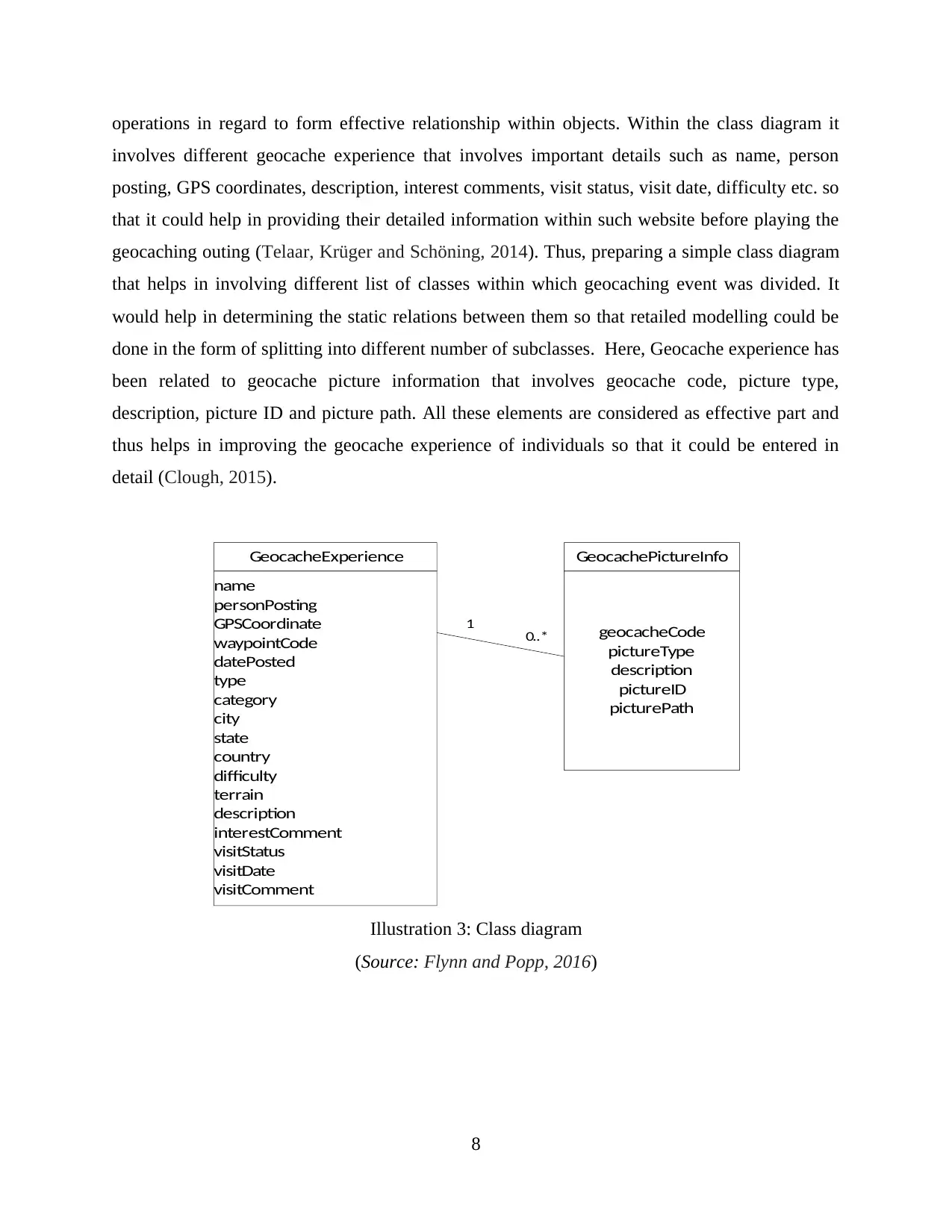
operations in regard to form effective relationship within objects. Within the class diagram it
involves different geocache experience that involves important details such as name, person
posting, GPS coordinates, description, interest comments, visit status, visit date, difficulty etc. so
that it could help in providing their detailed information within such website before playing the
geocaching outing (Telaar, Krüger and Schöning, 2014). Thus, preparing a simple class diagram
that helps in involving different list of classes within which geocaching event was divided. It
would help in determining the static relations between them so that retailed modelling could be
done in the form of splitting into different number of subclasses. Here, Geocache experience has
been related to geocache picture information that involves geocache code, picture type,
description, picture ID and picture path. All these elements are considered as effective part and
thus helps in improving the geocache experience of individuals so that it could be entered in
detail (Clough, 2015).
name
personPosting
GPSCoordinate
waypointCode
datePosted
type
category
city
state
country
difficulty
terrain
description
interestComment
visitStatus
visitDate
visitComment
GeocacheExperience
geocacheCode
pictureType
description
pictureID
picturePath
GeocachePictureInfo
1
0..*
Illustration 3: Class diagram
(Source: Flynn and Popp, 2016)
8
involves different geocache experience that involves important details such as name, person
posting, GPS coordinates, description, interest comments, visit status, visit date, difficulty etc. so
that it could help in providing their detailed information within such website before playing the
geocaching outing (Telaar, Krüger and Schöning, 2014). Thus, preparing a simple class diagram
that helps in involving different list of classes within which geocaching event was divided. It
would help in determining the static relations between them so that retailed modelling could be
done in the form of splitting into different number of subclasses. Here, Geocache experience has
been related to geocache picture information that involves geocache code, picture type,
description, picture ID and picture path. All these elements are considered as effective part and
thus helps in improving the geocache experience of individuals so that it could be entered in
detail (Clough, 2015).
name
personPosting
GPSCoordinate
waypointCode
datePosted
type
category
city
state
country
difficulty
terrain
description
interestComment
visitStatus
visitDate
visitComment
GeocacheExperience
geocacheCode
pictureType
description
pictureID
picturePath
GeocachePictureInfo
1
0..*
Illustration 3: Class diagram
(Source: Flynn and Popp, 2016)
8
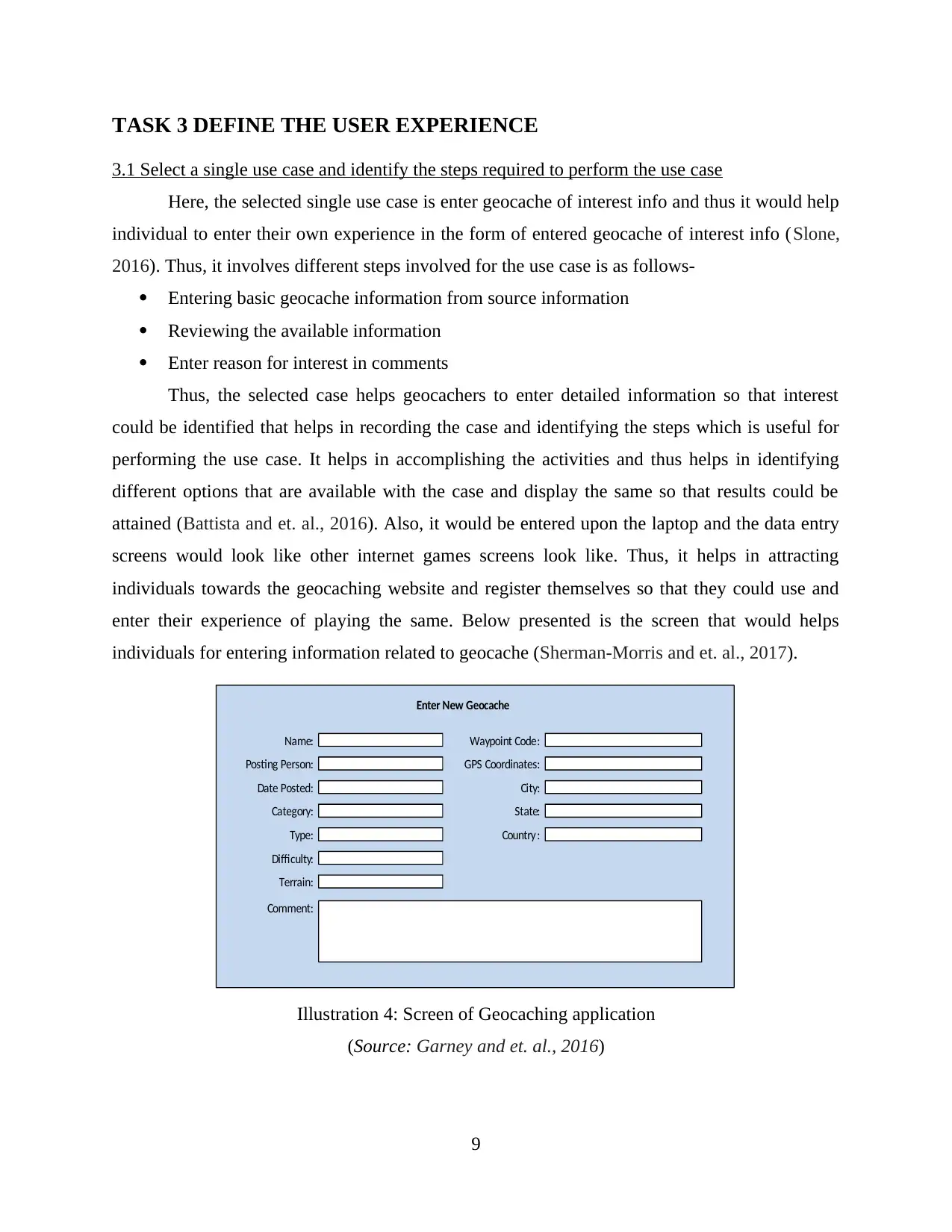
TASK 3 DEFINE THE USER EXPERIENCE
3.1 Select a single use case and identify the steps required to perform the use case
Here, the selected single use case is enter geocache of interest info and thus it would help
individual to enter their own experience in the form of entered geocache of interest info (Slone,
2016). Thus, it involves different steps involved for the use case is as follows-
Entering basic geocache information from source information
Reviewing the available information
Enter reason for interest in comments
Thus, the selected case helps geocachers to enter detailed information so that interest
could be identified that helps in recording the case and identifying the steps which is useful for
performing the use case. It helps in accomplishing the activities and thus helps in identifying
different options that are available with the case and display the same so that results could be
attained (Battista and et. al., 2016). Also, it would be entered upon the laptop and the data entry
screens would look like other internet games screens look like. Thus, it helps in attracting
individuals towards the geocaching website and register themselves so that they could use and
enter their experience of playing the same. Below presented is the screen that would helps
individuals for entering information related to geocache (Sherman-Morris and et. al., 2017).
Enter New Geocache
Posting Person:
Date Posted:
Category:
Type:
Waypoint Code:Name:
GPS Coordinates:
City:
State:
Country :
Difficulty:
Terrain:
Comment:
Illustration 4: Screen of Geocaching application
(Source: Garney and et. al., 2016)
9
3.1 Select a single use case and identify the steps required to perform the use case
Here, the selected single use case is enter geocache of interest info and thus it would help
individual to enter their own experience in the form of entered geocache of interest info (Slone,
2016). Thus, it involves different steps involved for the use case is as follows-
Entering basic geocache information from source information
Reviewing the available information
Enter reason for interest in comments
Thus, the selected case helps geocachers to enter detailed information so that interest
could be identified that helps in recording the case and identifying the steps which is useful for
performing the use case. It helps in accomplishing the activities and thus helps in identifying
different options that are available with the case and display the same so that results could be
attained (Battista and et. al., 2016). Also, it would be entered upon the laptop and the data entry
screens would look like other internet games screens look like. Thus, it helps in attracting
individuals towards the geocaching website and register themselves so that they could use and
enter their experience of playing the same. Below presented is the screen that would helps
individuals for entering information related to geocache (Sherman-Morris and et. al., 2017).
Enter New Geocache
Posting Person:
Date Posted:
Category:
Type:
Waypoint Code:Name:
GPS Coordinates:
City:
State:
Country :
Difficulty:
Terrain:
Comment:
Illustration 4: Screen of Geocaching application
(Source: Garney and et. al., 2016)
9
⊘ This is a preview!⊘
Do you want full access?
Subscribe today to unlock all pages.

Trusted by 1+ million students worldwide
1 out of 20
Related Documents
Your All-in-One AI-Powered Toolkit for Academic Success.
+13062052269
info@desklib.com
Available 24*7 on WhatsApp / Email
![[object Object]](/_next/static/media/star-bottom.7253800d.svg)
Unlock your academic potential
Copyright © 2020–2025 A2Z Services. All Rights Reserved. Developed and managed by ZUCOL.




